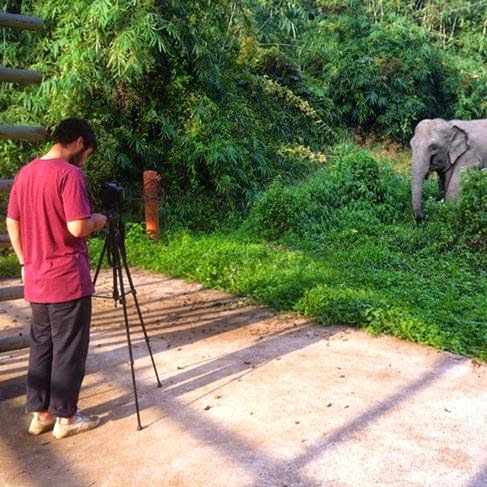As a medium, the documentary film is rising to compete and
contribute to media as a hub of popular attention. Viewers are becoming more
interested in learning while they watch television, which in my opinion, is one
of the more positive developments the tube has gone through. Films are stirring
up topics in fields like political science, sociology, psychology, biology, and
history! The list goes on! They are rich, refreshing, and allow the viewer to develop
opinions about current events. I want to explore this media format and discuss
how it is being utilized to influence scientific literacy.
By definition, the documentary is a non-fiction motion
picture used to document reality, often for archival purposes. Historically, the
term documentary has been around since 1926. But decades before its birth,
filmmakers were using the medium to document human behavior. Once it was known
as a tool for spreading information, films ranged from government propaganda to
nature footage.
Documentaries are now ubiquitous on the web and are growing
to represent a more significant chunk of screen time. Within seconds I am able
to learn about colony collapse disorder in honeybees, the history of jazz with
Ken Burns, or how the dam/hydroelectric power model in the US has reached its
culmination. The viewer can connect with still images, beautifully crafted
shots, and listen to listen to expert interview from both sides of a story.
Personally, I enjoy the documentary because it’s likely to
tell a tale that isn’t fit for the box office. Filmmakers are doing their
research to document aspects of society and our planet that aren’t as sexy as Transformers 4. Because
its purpose is to disperse information and not solely to be produced for profit,
filmmakers have more freedom in what they can and can’t do. Documentaries are
also overall cheaper to produce, thus leaving more room for creativity and
improvisation.
But why all of a sudden is it “cool” to watch something
educational? I think the jump in interest is a tag team performance: being
environmentally and culturally aware is more critical to society now, and that
change is being tapped by artists looking to be creative with content. It
surely has roots in the improvement of quality seen in environmental
documentaries, but one of the strongest candidates for being most influential
would be the Nobel Peace Prize winning doc An
Inconvenient Truth (2006) inspiring a new wave of activists. I think we’re
learning how important it is to take care of the planet, but just as important,
we need to learn how. And through visual media, it all makes sense!
We primates are visual learners. We use our eyes to
communicate with other humans to gather and process information. Every body
posture, facial movement, change in tone of voice is processed in your personal
computer (brain). Humans have evolved with this capacity because we’re social
beings. We began to evolve in an arboreal landscape where our eyes judge
distances of tree branches, ripeness of fruit, and the facial and body signals
from friends and foes. We learn so much from data collected though our eyeballs,
so I’d say it’s possible that learning through a screen could be another
effective method.
Maybe my favorite side effect, the documentary allows us to
take the perspective of another individual. To see how other humans, animals,
and environments change instantly, is special. Looking at wildlife
conservation, it’s difficult to connect someone with elephants, tigers, or
mangrove forests when they contently reside in a city on another continent. The people we see in these films could be our neighbors or
citizens of the most remote regions on earth. But we come to learn that our
cultures share similar themes and stories only with different characters and
settings.
Cinema can connect the viewer to those lessons deemed unnecessary
by curricula. A quite solid collection of material, The National Parks: America’s Best Idea (2009) by PBS and Ken Burns
delves into how the idea of the national park was first introduced. It’s a
story I don’t recollect from my early days in social studies class; however, it’s
very possible the ideas just didn’t form memories. But having an extra visual
component showcasing the wildlife found in Yellowstone could have solidified
that memory. And look at how crisp and stunning HD wildlife footage can be with a series like Planet Earth by the BBC. Images and creatively
selective content teach the viewer how to appreciate ecosystems and animal
behavior strictly through observation. Less admired animals have some screen time, contributing
to the idea that all members of the animal kingdom deserve your attention. That
connection, no matter how small, can form bonds that change behavior. Below is
why that’s vital.
Today, half of earth’s population lives in another jungle: the
concrete kind. The natural world exists, but it might as well be as far as Mars
for the billions of people who don’t have the time, urge, or travel funds to
experience them first-hand. The doc could be utilized to connect and spark an
interest in those who never would have thought to travel to Yosemite instead of
Disneyland, or the park down the street instead of the shopping mall. Keeping people connected to
nature through smart phones and TV is better than nothing at all.
Here at TEI, we want to contribute to the educational video
content on the web and provide the viewer with yet another possible source of
info. Over the next few months, we’re working to create fresh, segmented
YouTube videos (short documentaries) dedicated to animal behavior and cognition.
Our aim is to introduce and expose the viewer to a new perspective about how
our neighbors (animals) behave. We hope some of you enjoy the content and gain
a higher appreciation for how other animals perceive their world. And maybe
you’ll step away with an itch to familiarize yourself with any number of the
credible information mediums from print and digital media.
#Oh,Behave! #ForgettingSarahMusthBull








